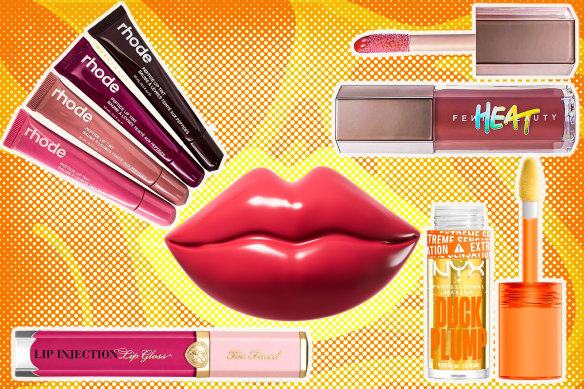Burn, baby, burn: Do lip-plumping beauty products actually work?
By Nell Geraets
Lip-plumping glosses were all the rage in the early 2000s. Products like DuWop’s “Lip Venom” and Too Faced’s “Lip Injection” dominated the market, encouraging people to lather on layers for juicier, fuller lips. The more intense the burning sensation, the better.
Interest in these ultra-glossy products waned as the 2010s approached, a time when the matte look reigned supreme and lip fillers were gaining popularity. But over time, the cost of lip filler, and the need to continuously return for touch-ups, put some people off. Many even began dissolving their filler.
And so, less invasive and cheaper plumping methods resurfaced. Once again, make-up stores are packed with glosses, balms, butters and oils that promise a blinding shine and plumper pout. Meanwhile, influencers are spruiking products like the Rhode Peptide Lip Treatment or NYX’s Duck Plump glosses on TikTok.
So, with lip-plumping glosses back in vogue, let’s investigate how they work, and whether they can really change your lips.

Lip-plumping gloss has made a major comeback, but do they actually work?Credit: Compiled by Monique Westermann.
Why do they burn?
Plumping glosses usually result in a burning, tingling, cooling or numbing sensation when applied. Dermatologist University of Melbourne associate professor Rosemary Nixon says this is often due to the irritant agents they contain, including capsaicin (a chili pepper extract), menthol, cayenne pepper, cinnamon and ginger.
“The lip plumpers cause skin irritation – technically irritant contact dermatitis or non-immunologic contact urticaria – which increases blood flow. This causes temporary swelling,” Nixon says, noting that they have a similar effect as eating spicy food.
Everyone reacts to these ingredients differently, meaning some may experience more extreme sensations than others.
Will they actually make my lips fuller?
Sherine Youssef, co-founder of beauty newsletter gloss etc, says lip plumpers are ideal for those searching for a quick, temporary fix.
“Maybe you missed a lip filler appointment, you’re trying to stretch the time between appointments to save money, or you’ve got a last-minute social engagement. A lip-plumping gloss can offer a similar effect [as filler].”
However, beauty scientist Hannah English says they cannot be directly compared to lip filler, which reaps almost instantaneous and semi-permanent results. In comparison, lips will cease to look fuller once lip plumpers wear off and blood flow returns to normal.
There are few peer-reviewed studies on the effects of lip plumpers. However, according to a study in the Journal of Clinical and Aesthetic Dermatology, certain active ingredients, such as peptides, in newer lip plumpers boost collagen synthesis, which reduces dryness and increases volume. Following a 28-day trial using these products, participants showed improved lip density.
Do plumping primers and moisturisers work the same way?
Plumping primers, such as the Too Faced face plumping primer serum, are usually hydrating or pore-filling products, says cosmetic chemist Dr Michelle Wong. Unlike lip-plumpers, they generally don’t contain irritants since that could mean potential exposure to the eyes.
“These are safe to use regularly. In fact, it’s better to use hydrating products than not, since skin functions best when hydrated,” Wong says.
English agrees, adding that many of these products probably contain humectants, like hyaluronic acid or glycerin, which draw water into the skin to plump immediately, as well as peptides. These are less likely to cause tingling or burning sensations on the skin.
Are they safe?
Nixon says she would not recommend lip-plumping glosses to her patients, but notes they are generally safe.
“Some people may simply find them too uncomfortable,” she says. “Some of the ingredients could cause allergic contact dermatitis, which is a delayed reaction starting some four to six hours after application, and which is detected by patch-testing. But if people have that reaction, I suspect they just avoid using them.”
Youssef says irritation can result in redness and dry or cracked skin. She also warns frequent use could result in the opposite desired effect, as constant swelling and irritation could eventually thin the lip’s skin barrier.
If lip-plumping gloss causes dryness or hypersensitivity, cosmetic chemist and Lab Muffin creator Dr Michelle Wong suggests using a thick layer of bland products, such as Vaseline. She also recommends avoiding products with potential irritants like fragrance or flavour, and to ensure toothpaste and food are thoroughly washed off the lips.
“Children, anyone with sensitive skin, and those allergic to the specific ingredients should avoid lip plumpers,” Wong says.
Notably, lip-plumping glosses have evolved since the early 2000s. Fewer products contain active irritants, English says, instead opting for gentler ingredients like peptides, hyaluronic acid, glycerin and oils like avocado and shea butter.
“You might see benzyl nicotinate or methyl nicotinate, which dilate the blood vessels to increase blood flow and cause some swelling, but no pain,” English says. “Vectorised hyaluronic acid, like that used in our tbh Rebound Stay the Night Lip Treatment, works by increasing hydration in the skin, which plumps in a less dramatic, but more comfortable way. We’ve also used peptides, which encourage the skin to build structural proteins.”
What are the alternatives?
For those who are uncertain, Wong recommends moisturisers and hydrating lip balms, which can make lips appear fuller without any accompanying sensation.
Alternatively, products that contain filling spheres (dehydrated water-absorbing particles) can make lips look plumper, as they swell up following exposure to water. “There are also anti-ageing skincare actives that some people use to try to attain longer-term changes, but the ingredients typically used like peptides have limited evidence.”
Make the most of your health, relationships, fitness and nutrition with our Live Well newsletter. Get it in your inbox every Monday.